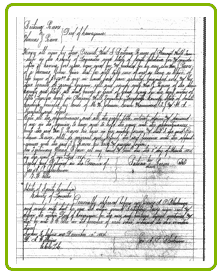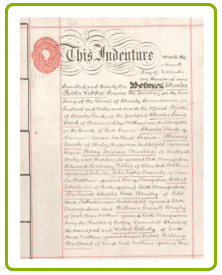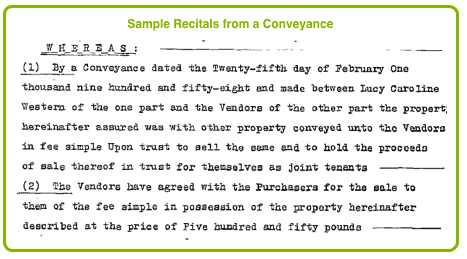Pre-Registration Title Deeds
Before the introduction of compulsory Land Registration the whole conveyancing process was carried out using deeds to convey the property from the seller to the buyer. The actual purchase deed was called a Conveyance, and many times during the ownership of a property there would be various deeds drawn to reflect changes made to the manner of ownership, e.g. a trust might be declared, a mortgage may be taken out or terms in the conveyance may be varied. In the past such documents were handwritten and upon a sale a solicitor would often provide yet another handwritten document in the form of an epitome, summarising the documents and contents of the title root.
As improvements evolved to the conveyancing system (most notably with the Law of Property Act 1925), conveyancing was simplified, ownership was established by proving a good root of title of at least 15 years (chain of ownership), and documents were typed instead of handwritten.


Compulsory Land Registration
Land Registration was eventually introduced, but this was voluntary at first. It provided a much simpler means of transferring ownership of a property, and eventually Land Registration became compulsory. Compulsory land registration was phased in throughout the country over a long period of years, but now all areas of England & Wales are subject to compulsory land registration.
The Law of Property Act 1988 made it possible for all members of the public to be able to obtain a copy of the Title documents without the consent or knowledge of the owner. The Land Registration Act 2002 and the Land Registration Rules 2003 have extended access to Land Registry documents further to those documents listed later in this guide.
Deeds
Ownership details and proof of ownership of a property are now evidenced by the Title Register and Title Plan. Notwithstanding this, the old deeds and documents left over from the pre-registration system of conveyancing remain with us and still have a vital role to play in many aspects of property ownership.
Post-registration conveyancing is governed by the Land Registration Act 2002 and requires most deeds to be in a form approved by the Land Registration Rules 2003. The purchase deed is now called a Transfer. A simple transfer of the whole of a title is in Form TR1; a transfer of part only of the title, in form TP1.
Some parcels of land are subject to many covenants, easements, restrictions, agreements, etc and the modern Transfer or old Conveyance may contain many pages containing voluminous details of the same. There may also be other deeds recording agreements entered into between the parties, again containing much detail. As a general rule the Land Registry will try to produce a Title Register (the main document proving ownership under Land Registration) that contains all this detail. Where it is too much, however, a reference will be made to the deed containing it and a copy of the deed may be retained in digital format by the Land Registry so that it can be provided to people requiring further detail, e.g. on the sale of a property, where there is a dispute about the boundaries of the property or where there are issues relating to rights of way, rights of access, rights of light, etc.
Types of Deeds
The following type of Deeds are typical of those available using our Deeds Searches:
- Purchase Deeds:
- Conveyancyes
- Transfers of Whole
- Transfers of Part
- Agreements
- Epitomes of Title
- Abstracts of Title
- Licences
- Declarations, e.g. Tenancy in Common
- Deeds of Covenant
- Deeds of Gift
- Assent
- Applications made to HM Land Registry
- Edited Exempt Information Documents
- Non-Edited Exempt Information Documents (authorised persons only)
Recognising the different types of Deeds is useful, especially if you want to look at the history of a property. All Deeds vary considerably in size and content, and the purpose of Deeds likewise vary; conveyances and Transfers convey the property from one party to another; an epitome summarises the documents found in the root of title; an abstract of title provides a short form of the root of title; a transfer of part, as opposed to a transfer of whole transfers just a part of the property to another person, e.g. where the land has been split into plots and one plot is being sold while another is being retained; an Assent transfers a property from the estate of a deceased person to a living person.
Content of Purchase Deeds
Purchase Deeds can be purchased using our Deed Search. Purchase Deeds (Transfers and Conveyances) all contain specific clauses that do a particular job, and are contained in the following order:
Commencement
Purchase Deeds usually start with words similar to "This Conveyance ..." Such words are intended to describe what the document is and the purpose it serves.
Date
This is the date that the transaction was completed upon.
Parties
The names and addresses of the vendor and purchaser are set out.
Recitals
The purpose of recitals is to describe the background or history behind the purchase, and usually begin with the word "Whereas", e.g. "Whereas the vendors have agreed with the purchasers for the sale to them of the fee simple in possession of the property hereinafter described at the price of one hundred pounds ..."

Consideration and Receipt
The consideration is the purchase price and confirms the conveyance is not a voluntary conveyance, and enables, prior to Stamp Duty Land Tax, stamp duty to be assessed under the Stamp Act 1891.
The receipt clause is evidence that payment has been made.
Operative Words
These words operate to pass the seller's interest in the property to the purchaser, e.g. "convey" or "transfer".
Capacity and Implied Words
Prior to 1995 the words showing the seller's capacity where placed into a conveyance as they determined the covenants for title that would be implied. However, with the enactment of the Law of Property (Miscellaneous Provisions) Act 1994 if any covenants for title were to be implied, the words "with full title guarantee" or "with limited title guarantee" are used.
Parcels Clause
The Parcels Clause provides the legal and physical description of the property being conveyed. It is paramount that the property be described accurately, whether with or without a supporting plan. Often the Parcels Clause will refer to a plan in an earlier deed.

Habendum
The Habendum Clause describes the estate being sold, i.e. the fee simple (freehold) or term of years (leasehold).

Encumbrances
An encumbrance (or incumbrance) is something that restricts a person's use of the property such as an adjoining owner's right to pass along your driveway (an easement). Any existing encumbrances will usually be detailed immediately after the habendum clause to show that the estate in the property is being conveyanced subject to those encumbrances, and then followed by any new encumbrances.
Indemnity Covenant
If the seller of the property is to remain personally liable for a covenant affecting the land following the sale then he should require an indemnity covenant from the purchaser.
Acknowledgement and Undertaking
Where a seller is retaining part of the land for himself he will normally need to hold on to the original deeds. He will therefore formally acknowledges the right of the purchaser to the production of the deeds if he so requires them at a future date and undertakes to keep them safe. He will, of course, have been provided with certified copies of the originals in the meantime.

Certificate of Value
Prior to 2003 this clause was necessary to show an exemption from payment of Stamp Duty was claimable, as where the property was being sold below the Stamp Duty threshold.

Execution and Attestation
The conveyance must be signed by all sellers. The purchaser will only do so if he has agreed to do something in the conveyance such as providing an indemnity covenant. The signatures must be formally witnessed.
How to know which Deeds are available for Purchase
All Deeds that have been copied by the Land Registry, and retained digitally, have a note recorded at the foot of the paragraph in the Title Register that refers to the Deed to the effect that it has been copied.